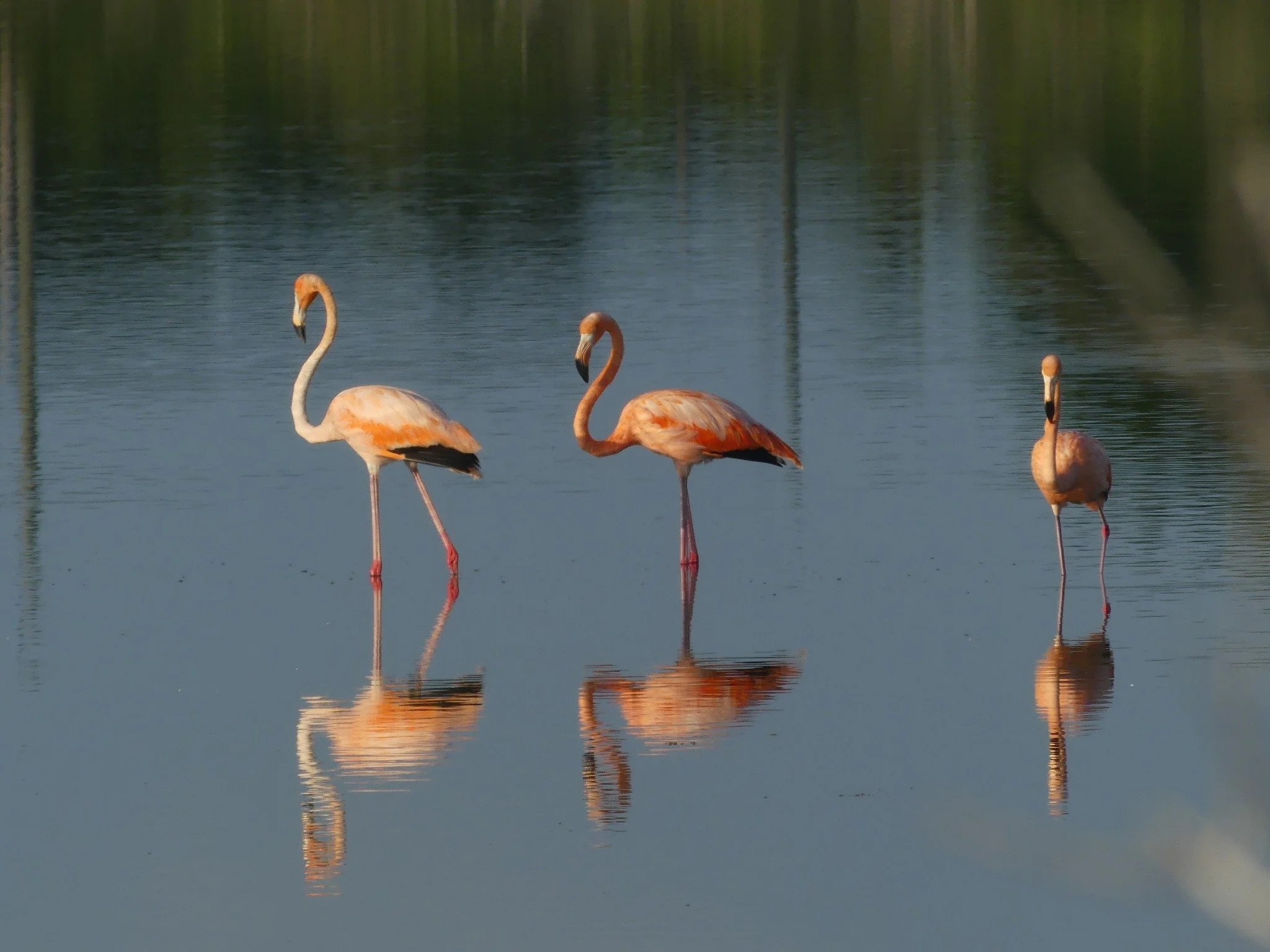Posted September 14, 2023, by Brian Rapoza
Since Hurricane Idalia passed through Florida at the end of August, American Flamingos (Phoenicopterus ruber) have been found in at least 18 Florida counties, mostly along the coast, but also in a few inland areas.
The American Flamingo is normally found throughout much of the Caribbean, including the Bahamas, Cuba, Hispaniola, the Yucatan Peninsula, and the northern coast of South America, with occasional appearances in South Florida. There is also an isolated population in the Galapagos Islands off the coast of Ecuador. While American Flamingos are now considered native to Florida, there is only anecdotal evidence that they have ever bred here.
Historically, thousands of American Flamingos wintered annually in Florida Bay, most coming from breeding colonies in the Bahamas. By the turn of the 20th century, however, the slaughter of wintering birds by plume hunters, along with the destruction of Bahamian breeding colonies, resulted in the eventual disappearance of this wintering population from Florida Bay. During the ensuing decades, flamingos were rarely seen in the wild in South Florida. Those rare sightings were generally assumed to have been of birds from the free-flying flamingo flock introduced to Hialeah Racetrack in the 1930s, though little evidence exists to support this assumption.
Beginning in the early 1990s, flocks of up to several dozen flamingos began to winter again in Florida Bay, though annual numbers fluctuated considerably. During some winters, no flamingos were seen in the bay. A banded bird found in the 2002 flock was determined to have originated from a breeding colony in the Yucatan Peninsula, finally providing proof that wild flamingos were once again migrating to Florida naturally. Flamingos would occasionally appear at other times of year and in other parts of Florida, including a flock of up to 145 individuals that appeared in a stormwater treatment area in Palm Beach County every spring from 2014 to 2018, but the origin of this flock was never determined.
Several flamingo records in Florida and elsewhere along the U.S. Gulf coast during summer and fall in the past few decades correlate strongly with the passage of hurricanes through the area. These records include the individual, nicknamed Pinky, that has been present at St. Marks National Wildlife Refuge near Tallahassee since the passage of Hurricane Michael in 2018. Except for the two individuals found in Monroe County after the passage of Hurricane Frances in 2004, all these records were of a single bird. None of these previous records could have prepared us for what happened after the passage of Hurricane Idalia through Florida and other southeastern states in late August.
Hurricane Idalia began as a tropical disturbance near the Yucatan Peninsula, eventually strengthening to a Category 4 hurricane before it made landfall in the Big Bend area of north Florida on August 30. Flamingos were found in three Florida counties that same day: 16 in Pinellas County, 7 in Lee County and 1 in Alachua County. On August 31, reports came from six Florida counties; by September 1, flamingos were being reported in several other states. The next day, a flock of more than 50 birds was seen at Estero Bay Preserve State Park in Lee County. By September 7, flamingos had been reported in ten states (listed here in the order sighted): Florida, Virginia, Ohio, South Carolina, North Carolina, Tennessee, Alabama, Texas, Kentucky and Pennsylvania.
These iconic birds became instant tourist attractions. Reports of them being stressed by photographers approaching too closely also surfaced. In Pinellas County, a dead flamingo was found near Honeymoon Island with no immediate known cause of death.
Another flamingo, apparently suffering from exhaustion, had to be rescued and taken to a rehabilitation facility. Nicknamed “Peaches,” the rehabbed bird reportedly recovered quickly and was released back into the wild with a transmitter on its leg to track its journey.
So where did all these flamingos come from and how did they get here? We know that one of the birds found in the Keys was banded by researchers in the Yucatan Peninsula. Did all the birds reported post-Idalia come from the Yucatan? The hurricane passed over western Cuba, so it’s possible that some birds came from there. We may never know for sure. As for how they got here, there are a lot of misconceptions regarding birds and hurricanes. It’s very unlikely that Idalia carried the flamingos here. More likely, birds that were already on the move may have been redirected our way as they tried to avoid the storm. There is still much to learn, but their unprecedented “invasion” may eventually provide some answers.
As for what eventually happens to all these hurricane-impacted flamingos, we’ll have to stay tuned and hope for a happy ending.
Sources:
Birds of the World (online), Cornell Lab of Ornithology
Florida Bird Species: An Annotated List, J Greenlaw, B Pranty, R Bowman, 2014
Hurricane Idalia Report 2023, Amy Davis, American Birding Association
Photo:
American Flamingos at a pond near a neighborhood on Tropical Ave. on Grassy Key.
By Rachel DiPietro

